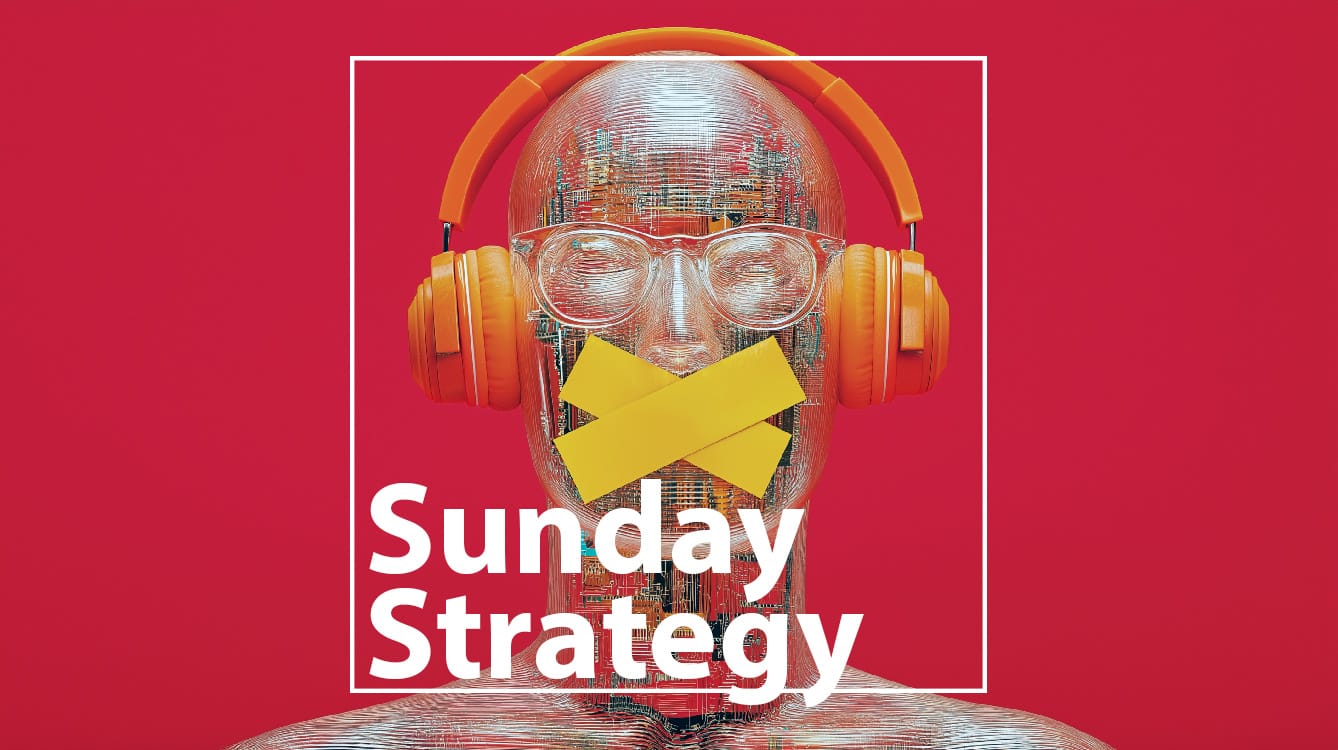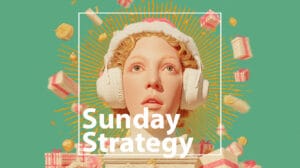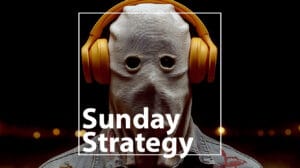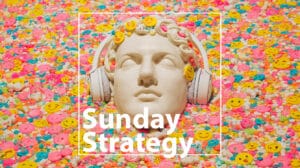In this issue of Sunday Strategy, we look at four stories to think about next week, including: AI’s Transparency Paradox, Can KFC Comeback, Multi-Tasking vs. Meetings and Synthetic Socialization.
In addition, we have ads from: John Lewis, JD Sports, Shelter, Facebook and Etsy.
// Stories of the Week:
1.) AI’s Transparency Paradox.
A new study shows the transparency challenge facing AI in advertising. Fully AI generated ads can increase click through rates (CTR) by 19%, but once users are told that the ads are AI generated, CTR plummets by 31.5%. The study highlights the transparency paradox in AI, greater integration of AI into everything from content creation to social media will increase calls for AI labelling and transparency, limiting AI effectiveness. AI effectiveness will simultaneously create greater use and integration of AI by brands and platforms.
So what can resolve this paradox? Brands and platforms are seemingly hoping time does the job for them. As consumers are more exposed to AI there is a hope that familiarity reduces negativity and makes effective transparency possible. However, this may take longer than expected, leaving brands to either:
- Commit fully to AI despite negativity (as Coca-Cola’s recurring holiday ads show),
- Use it as a foil in a type of meta acknowledgement (as Mint and others recently have), providing an ironic transparency at best,
- Actively reject it to highlight humanity (as seen with Kodak and others)
2.) How Can KFC Regain Its Chicken Crown?
Fast food chicken is booming, but as more competitors try to get in on the space, KFC is having to plot where it fits in the modern market. The chicken market has moved on since Colonel Sanders owned the 11 herbs and spices narrative, first with Chick-Fil-A and then with the rise of ‘Raising Caines’, ‘Wing Stop’ and others. Even seafood chain ‘Long John Silvers’ recently rebranded to put chicken front and center to get in on poultry.
The shift has driven KFC’s market share of chicken from 15% in 2019 to 9% in 2024, but beyond competition, changing consumer tastes have also challenged the brand. Eating in cars and greater consumption of boneless wings and wider chicken challenge the heritage of KFC. For the brand to gain its chicken crown, it will need to do more than steal it back from Chick-Fil-A, it will need to move beyond the buckets and bone-in chicken it’s been known for.
3.) Multi-Tasking vs. Meeting Culture
Meetings have always been a challenge for workers – offering collaboration and consensus at the cost of time to execute and act. With employees now doing more work in the same amount of time, amongst layoffs, restructures and increasing employer demands – meetings have become a pain point where multi-tasking meets attention. A 2024 Miro report showed that while a majority of workers thought they had the ‘right amount’ of meetings in their work day and 83% report ‘often’ or ‘always’ paying attention in meetings, 61% also reported ‘often’ or ‘sometimes’ multi-tasking during a meeting.
The WSJ reports that CEOs are increasingly angry about the presence of phones, multi-tasking and texting during meetings. However, is this a reflection of worker attention to meetings or increasing pressure to get other things done while still being ‘present’ in them? Policies to ban phones may treat the symptoms afflicting modern meetings without considering the underlying cause.
4.) The Risk of “Synthetic Socialization”
Modern social media, as we’ve written about before, isn’t social. However, what comes next may be worse. The rise of AI chatbots and integration of AI into relationships (either with others or directly with AI) is offering less ‘friction’ from how we socialize – arguably stripping out the difficulty, but also the value in human relationships. As the Atlantic puts it, “Every time there’s been a new technology, it’s rewired socialization, especially for kids. TV made kids passive spectators. Social media turned things into this 24/7 performance review.”
So what does AI do? Are we seeing an increase in ‘Synthetic Socialization’, switching real and messy social relationships for a ‘diet’ version with empty calories? AI’s impact goes wider than social media, as tricky aspects of social lives from dating to messaging are being shaped by it. It’s less likely we exclude AI from the social platforms and communications tools we use, so instead, is there still time to shape its use?
// Ads You Might Have Missed (Holiday Ad Special):
These are just a few of the 1,000+ ads we have listed in our Sunday Strategy Holiday Ad List. Check out ads from 2025 back to 1980 in list form or as a YouTube playlist.
1.) ‘Where Are You Going?’ – JD Sports:
JD Sports’ new holiday ad doesn’t just switch the traditional dynamic, it’s part of a wider journey to get closer to the audience you serve. The brand and their agency, Uncommon, have done brilliant work over the last few years to authentically show how JD Sports sees young people’s lives.
From 2023’s ‘Bag For Life’, showing holiday life around their bag, to 2024’s ‘Family Portrait’, giving a polished but realistic view of what family means – they’ve committed to strategically focusing on the real lives of young people against a holiday season of big budget ads and fantasy. The logical progression of that strategy continues this year, as they’ve given phones to 286 different young individuals around the world and used the footage captured as their 2025 ad.
The result isn’t just a portrait of what young life looks like at the moment or a lo-fi contrast vs. market’s holiday celebration. It’s also a reminder that simply saying you focus on your audience isn’t enough, you have to continuously find new ways to get closer and renew that commitment.
2.) ‘Where Love Lives’ – John Lewis:
Saatchi & Saatchi continues the unenviably enviable task of bringing the UK’s most famous annual ad to life – in a way that meets expectations but also puts a unique stamp on it for the brand as culture changes. The 2025 entry ‘Where Love Lives’ shifts from mascots, aliens, bears and cute dragons to focus on a human story between a father and son. Tapping heavily into the 90s nostalgia rife in advertising at the moment, it sees the son, who’s drifted apart from his father, give him a vinyl record of the 90s house classic ‘Where Love Lives’. The gift transports him back to a 90s nightclub and reconciles the gap between them in the present day.
Featuring a slower version of the track by Labrinth, the ad holds up the brand’s tradition of remaking the music featured from standards. However, its departure from ‘entertaining tear jerker’ to ‘personal tear jerker’ is a new adaptation. Whereas previous entries aimed to make a wide swath of the UK public feel a little something (with penguins, bears / hares and more), this entry and last year’s ‘Gifting Hour’ show a more focused emotional approach, aiming to make those the ad resonates with feel a deeper response at the cost of wider relevance.
3.) ‘Christmas Appeal’ – Shelter:
UK housing charity ‘Shelter’ has continued their annual approach of raising awareness of homelessness during the holidays through the eyes of children. 2025’s Appeal features Bonnie Tyler’s ‘Total Eclipse of the Heart’ used first as a child’s joyous song and secondly as hold music while his mother waits to try and coordinate housing. The ad’s rugpull approach mirrors 2024’s ‘World of Our Own’ and 2023’s ‘Good as Gold’, in luring viewers in through more expected child focused holiday narratives, before shifting to the hard hitting issue of homelessness.
The ads themselves tackle the charitable challenge of holiday giving and guilt directly. Running the risk of alienating some, so that those who do engage feel motivated enough to act. The rugpull strategy seems to bank on time spent helping to drive this motivation. With no one way to drive charitable engagement during a holiday season, filled with competitive moments of giving and moments of distraction – the urgent and aggressive approach is warranted, even if it polarizes. For Shelter, children in families experiencing homelessness during the holidays warrant taking the risk of subverting the season’s expected messaging.
4.) ‘Home for the Holidays’ – Facebook:
Is Meta’s holiday ad for ‘Facebook’ the start of a repositioning for a platform that aims to return to its roots, or a wistful piece of nostalgia for a social network that can’t go home again? Meta’s ‘Home for the Holidays’ puts familiar Facebook territory on show, as users old enough to remember it nostalgically head home for the holidays and use the platform to connect with each other. Soundtracked to ‘Girl from the North Country’, the ad unfurls cinematically in a way that makes a strong case for what the platform was and wants to be.
However, as younger audiences frequently use it as an eBay alternative and many associate it more with your relative’s questionable political memes – can the brand turn back the clock or does it have to accept it needs to be something new? Like the high school hero quarterback coming back home for Christmas in his 30s, is Facebook looking backwards when it should be writing a new chapter or at least acknowledging the time and events that have passed? This may be one ad that reflects as much about how the brand is feeling vs. how it wants its users to feel.
5.) ‘Little Drummer Boy’ – Etsy:
Etsy’s 2025 holiday ad takes its ‘Gifts That Say I Get You Idea’ and translates it into even more personal terms. “Little Drummer Boy” sees Alex, a child with a habit of drumming on anything, often to the detriment of himself and those around him, get gifted a set of drum sticks which open up a musical future. Moving more individually vs. last year’s “Where’s Waldo” ad, the brand takes a measured tone in the ad that resonates in specific meaningful moments. For a marketplace beset with AI generated content and a need to fight off cheap social commerce, the choice of gift and moment is interesting. While the drum sticks and gifter, a teacher to a student vs. more personal relationships, are less emotionally charged, it potentially reflects the wider moments Etsy would love to own in the holiday season and beyond.
// Sunday Snippets
// Marketing & Advertising //
– Nike continues its marathon activations with billboards and a spread in the NYT post race Monday [Fitness]
– Apple projects users’ drawings of Christmas trees on Battersea Power Station [Technology]
– Burger King brings back their highly sought after ‘BK Advent Calendar’ [Food]
– Sheraton taps into ‘Goodnight Moon’ for their latest childhood focused ad [Travel]
– MSNBC’s rebrand into ‘MSNOW’ sees a new launch ad with hosts reciting the constitution [Media]
– TK Maxx combines classic hiphop and farm animals in their UK Holiday ad [Fashion]
– Goldfish returns to the Macy’s Thanksgiving parade this year with the world’s smallest float [Food]
– Auckland launches taxis to take people to ‘the heart of the city’ in mystery taxis [Tourism]
– Liquid Death are sponsors of the Running Man film because, of course they are [Food]
– Target leans into employee smiles to try and increase in-store positivity [Retail]
– Gatorade jumps on 80s nostalgia in advance of the final season of ‘Stranger Things’ [Food]
– Discover also finds 80s nostalgia through a ‘Stranger Things’ themed ad featuring Natalia Dyer and Charlie Heaton [Finance]
– Baskin Robbins has brought back their ‘Turkey Ice Cream Cake’, but prices vary wildly by location [Food]
– Move over ginger bread, Cheez-it launches the Cheez-it Holiday House [Food]
– Nike rolls the credits on the Dodgers back to back World Series wins in a new ad [Sports]
– KitchenAid is launching ‘Room to Host’, a space in NYC’s West Village kitted out for holiday hosting and dinner parties [Brands]
// Technology & Media //
– Viral TikTok Challenge wipes out Australia’s supply of ‘Clinkers’ [Social Media]
– Airbnb aims to become more social by allowing travellers to connect with each other [Travel]
– How did Celebrity Traitors win over UK Gen Z? [TV]
– Google announces integration of odds from Kalishi and Polymarket [Technology]
– A24 and Netflix have announced they’re turning the game ‘Overcooked’ into a reality series [Gaming]
– Gracenote’s 2025 ‘State of Play’ streaming report shows the paradox of choice within the platforms [Media]
// Life & Culture //
– Why do we destroy good streetwear brands? Is it the inherent nature of ‘brand growth’? [Fashion]
– Is ageism getting worse in job searching? [Work]
– Is learning a trade the new ‘learning to code’? [Work]
– Dictionary.com’s word of the year is ‘6-7’, reflecting either a desperate need for better words or for someone to help dictionary.com out of a need to stay young and cool [Culture]
– The Cocktail Party T-Shirt: Fashion forward or sign of casual times? [Fashion]
– Cowdenbeath FC in Fife becomes the world’s first football club to offer a season ticket for dogs [Sports]
– Tacoma has elected their first (pet) mayor in Nacho the cat – no words on transition or tuna policy [Pets]
– The Taco Bell 50k (where you run an ultramarathon to different Taco Bell locations and eat) is coming to Washington DC in late November [Sports]
– Is Chinese marathon culture facing a bust amongst its current boom? Is it time for the Taco Bell 50k to go international? [Sports]
– Inside the ‘forehead kiss’ of doom and despair [Romance]
// Until Next Sunday
As always, let me know what you think by email (dubose@newclassic.agency), website or on LinkedIn.
You can also listen to an audio summary and discussion of each week’s newsletter on Spotify. We’re also on TikTok!





